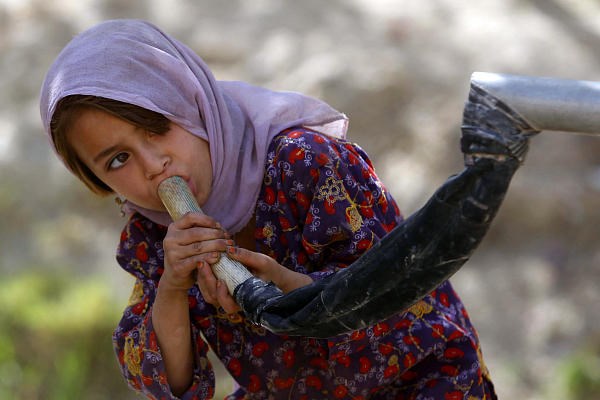Harnessing the bacteria naturally occurring in water and using solar energy are just two innovations that may help bring clean drinking water to the world's poor.

|
| An Afghan girl drinks water from a well through a makeshift faucet in a village in Kandahar Province in Afghanistan. March 22, 2012 is World Water Day. By 2025, 1.8 billion people will be living in countries or regions with water scarcity, the UN estimates. Techniques such as electrodialysis and solar purification could increase supplies of clean drinking water in developing countries. Erik de Castro/Reuters/File |
New engineering technologies look to quench the world's thirst for clean drinking water through cheap, green self-powered purification mechanisms.
Cleaning dirty water generally requires high energy and capital, placing clean water out of reach for many of the world's poor. But new innovations are making clean water more accessible by lowering the financial and environmental costs of purification.
Want energy with your water? Use bacteria. Engineer Bruce Logan of Penn State University is perfecting a process by which bacteria in wastewater generate the necessary electrical power to clean the water.
Most wastewater contains bacteria, and by altering the chemistry and physics of microbial fuel cell systems, Logan capitalized on the idea that bacteria can produce electric currents under anaerobic conditions where electrons link up with oxygen molecules.
"You and I eat food and generate energy," Logan told GOOD. So do bacteria. And when those bacteria are deprived of oxygen in a microbial fuel cell, the electrons they produce flow to the other side of the cell to find oxygen protons, creating an electric current as they travel.
Over time, Logan has improved the technologies of the process, including by combining the microbial fuel cell system with reverse electrodialysis, which captures the energy of ions as they flow through membranes from salty to fresh water. The fuel cell gives the energy boost for the reverse electrodialysis system, allowing the process to operate with fewer membranes and making the system cheaper to produce. The result is purified water that is free of bacteria and safe to drink.
So far, the amount of energy Logan says he can generate "almost matches the amount needed to process it," according to GOOD. That means Logan is closer to his goal of cost-effective clean energy wastewater treatment, and households, companies, and farms are closer to having cheaper, cleaner, greener water.
Canadian engineers harness African sun: In Angola, solar cells are already producing cleaner water. Canadian technology company Quest Water Solutions has teamed up with the Angolan government to develop and install drinking stations called "AQUAtaps," which use solar energy to purify drinking water inside used shipping containers.
Quest hopes that after a successful pilot program, the AQUAtaps will be manufactured locally throughout Angola.
The technology is "really quite simple and very low maintenance," according to Quest's John Balanko. The shipping containers, with solar panels on top, contain large batteries which store energy. That electricity pumps water from a nearby river through sand and filters, then sterilizes the water with the same UV rays that feed the panels.
The AQUAtap fits nicely with the Angolan government's "Agua para Todas" (water for all) initiative. Quest sells the equipment, and a two- year maintenance guarantee, to the government for a one-time fee, but it then belongs to the villagers. Once the program expands, Quest envisions local production jobs as well.
For Angolans, the AQUAtap project can bring clean water and local jobs with virtually no carbon emissions in the process. Now there's a solution people can raise their glasses to.
Page created on 5/14/2012 12:00:00 AM
Last edited 5/14/2012 12:00:00 AM
Extra Info
This article originally appeared at Global Envision, a blog published by Mercy Corps.

